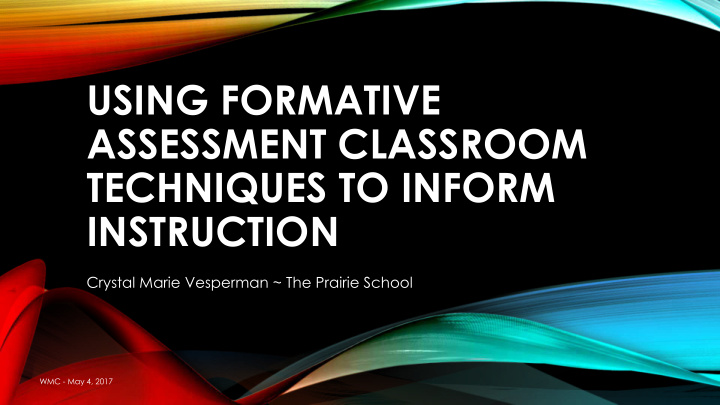



USING FORMATIVE ASSESSMENT CLASSROOM TECHNIQUES TO INFORM INSTRUCTION Crystal Marie Vesperman ~ The Prairie School WMC - May 4, 2017
VOLLEYBALL, NOT PING-PONG! • What do you think of when you think “formative assessment”? • How would you explain the purpose(s) of formative assessments to a parent? A supervisor? A student? • What do you hope to get out of this session today? WMC - May 4, 2017
SHARE OUT - VOLLEYBALL, NOT PING-PONG! • Have you used this in your classroom? • How could you modify this for your own students? • Questions? WMC - May 4, 2017
PURPOSES OF FORMATIVE ASSESSMENT • Research indicates that formative assessment can significantly improve student learning • Formative Assessment Classroom Techniques (FACTs) are used to gather information or promote students’ thinking and learning • Design or modify lessons to meet needs of students WMC - May 6, 2016
WMC - May 4, 2017 POLYGONS
FRAYER MODEL • Graphic organizer • Determine students’ prior knowledge • Non-examples are so important! WMC - May 4, 2017
SHARE OUT – FRAYER MODEL • Have you used this in your classroom? • How could you modify this for your own students? • Questions? WMC - May 4, 2017
WMC - May 4, 2017 AREA
COMMIT AND TOSS • Anonymous • Involves physical activity • Shares different ideas • Helps students see value in “wrong” ideas WMC - May 4, 2017
SHARE OUT – COMMIT AND TOSS • Have you used this in your classroom? • How could you modify this for your own students? • Questions? WMC - May 4, 2017
THREE MINUTE PAUSE • Provides time summarize, clarify, and self-assess whether students understand what’s going on in class • for hard topics • Students work in groups • When timer goes off, students resume the lesson • At the end of class, set aside another three minutes to resolve lingering questions • This can be done with teacher or whole class clarification WMC - May 4, 2017
SHARE OUT – THREE MINUTE PAUSE • Have you used this in your classroom? • How could you modify this for your own students? • Questions? WMC - May 4, 2017
WMC - May 4, 2017 SOLVING TRIGONOMETRIC EQUATIONS
MUDDIEST POINT • Students jot down most difficult or confusing part of lesson • Can be used like an exit slip at end of lesson • Be clear on how you will use the information WMC - May 4, 2017
SHARE OUT – MUDDIEST POINT • Have you used this in your classroom? • How could you modify this for your own students? • Questions? WMC - May 4, 2017
WMC - May 4, 2017 MEASURES OF CENTER
POMS • Point of Most Significance • Opposite of Muddiest Point • Used at end of lesson WMC - May 4, 2017
SHARE OUT - POMS • Have you used this in your classroom? • How could you modify this for your own students? • Questions? WMC - May 4, 2017
WMC - May 4, 2017 HOW DO YOU SOLVE THIS PROBLEM?
COUNT THE VOTES! • A recent location election included 5,219 votes cast for four candidates. The winner won by 22, 30, and 73 votes, respectively. How many votes did each candidate receive? WMC - May 4, 2017
STRATEGY HARVEST • First complete problem-solving task • Circulate among peers to find strategies that differ from own • Can be applied at different stages of learning process WMC - May 4, 2017
SHARE OUT – STRATEGY HARVEST • Have you used this in your classroom? • How could you modify this for your own students? • Questions? WMC - May 4, 2017
GREAT RESOURCE! WMC - May 6, 2016
WMC - May 6, 2016 THANK YOU! Want a copy of these slides? I’ll put them up on the WMC website, or email at cvesperman@prairieschool.com
Volleyball, Not Ping-Pong! • What do you think of when you think “formative assessment”? • How would you explain the purpose(s) of formative assessments to a parent? A supervisor? A student? • What do you hope to get out of this session today? Using Formative Assessment Classroom Techniques to Inform Instruction - WMC 2017
Frayer Model Using Formative Assessment Classroom Techniques to Inform Instruction - WMC 2017
Commit and Toss Square 1: Square 2: Square 1 has a side length of x units. Square 2 has a side length of 2x units. Circle the letter of the statement that describes how the area of Square 1 compares to the area of Square 2. A) Doubles in size B) Same size C) Quadruples in size D) Not enough information to compare Explain your reasoning: Using Formative Assessment Classroom Techniques to Inform Instruction - WMC 2017
Muddiest Point • Today we have been learning about trigonometric equations. What has been the muddiest point so far in today’s lesson for you? Please take a few minutes to jot down any ideas or parts to he lesson that were difficult for you to understand so I can address them for you tomorrow. Using Formative Assessment Classroom Techniques to Inform Instruction - WMC 2017
Point of Most Significance • Today we investigated and discussed different way to measure the center of data (mean, median, and mode). What point made during today’s lesson best helped you understand ways to measure the center of your dataset? Using Formative Assessment Classroom Techniques to Inform Instruction - WMC 2017
Strategy Harvest My Strategy: ________’s Strategy: ________’s Strategy: ________’s Strategy: Using Formative Assessment Classroom Techniques to Inform Instruction - WMC 2017
Recommend
More recommend